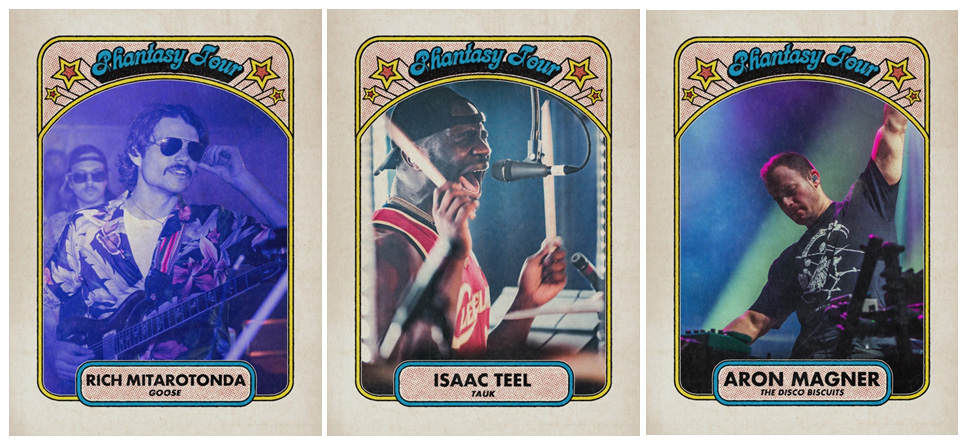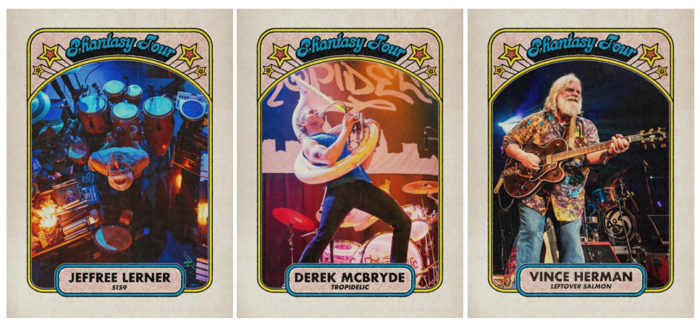Behind The Scene: A Look at PT Trading Cards

“I was a self-taught programmer,” explains Phantasy Tour founder Paul Glace. “I’d always had an interest in technology and, when I was in college, I learned about the World Wide Web and sought out every opportunity I could to experiment with this new thing, even though I wasn’t an IT major or programming major. So I began building websites for various societies on campus, as well as my fraternity. I was looking for any outlet to do something on the web because it was amazing—you’d immediately put something out there and people were using it.”
Glace was also an avid Phish fan who saw the band for the first time when they appeared at Penn State’s Recreation Hall on April 18, 1994, during his freshman year at the school. (Glace took his then-girlfriend, now-wife to the show.)
While attending Phish’s 1998 Las Vegas Halloween run, he began to think seriously about blending his passion for the band and his fascination with the internet. “It was then that the idea for Phantasy Phish really came to the forefront,” he recalls. “I thought, ‘Wow, this is something I can do. I can put this up on the web, people can predict setlists and we can score it in real-time. People can compete and get instant results no matter where they are located.’ It took me over nine months to gain the skills to make it happen, but I published it in time for that early fall tour.”
When Glace launched his project in September 1999, the initial URL was Phantasyphish. com. However, just over a year later, Glace moved the site to its current home, Phantasytour. com. “I realized that the name was very confining and that it wouldn’t necessarily sit well with the Phish organization,” he reveals. “So in the interest of not having the band’s name in the title, as well as giving me the latitude to expand the idea to other groups, I transitioned to Phantasy Tour, but I left the ‘ph’ in Phantasy as a nod to my favorite band.”
Another change was a bit more gradual. For many years, Phantasy Tour remained an intense hobby for Glace. During that time span, he “pursued a career in what started as a classical industrial engineering job, but then transitioned into management consulting. That’s where I learned a lot of business skills. This data-driven mentality was always there and was definitely a catalyst to why I was interested in setlist analytics, predictions and things of that nature.” However, after 15 years, he finally committed himself full-time to Phantasy Tour, sprucing it up and expanding its reach beyond the existing slate of bands and message boards.
His latest endeavor is Phantasy Tour Trading Cards. These collectibles, which are a throwback to the baseball cards of the 1970s and ‘80s, feature nine different bands. (Leftover Salmon, the Disco Biscuits, STS9, Pigeons Playing Ping Pong, Tropidelic, TAUK, Goose, Bumpin Uglies and The Jauntee). Each pack contains a checklist as well as nine randomly sorted cards representing the participating groups, through either an individual member or the entire band.
While the cards will eventually be sold at each artist’s live gigs, in the interim, they can be found at the Phantasy Tour merch site: merch.phantasytour.com.
When did the idea for Phantasy Tour Trading Cards first occur to you?
It’s hard to say when I really started thinking about it because I probably had been thinking about it since I started getting into this music as a teenager. But it really got traction at the beginning of 2019 when we approached Pigeons Playing Ping Pong about doing a run of cards featuring the four members of the band. It was largely conceived as a cross-promotional opportunity where we would make the cards, brand them Phantasy Tour and give them out to fans at their January 2019 shows in Asbury Park. It was really based on the response to that, and we said, “Hey, this is something people want. They’re really digging it.”
So I started contacting bands and talking about how to make it work for them. I also started contacting photographers to figure out how to piece it all together and make it happen. Admittedly, we run a technology company, not a merchandise company, so it took a backseat a couple of times throughout the year. We celebrated our 20th anniversary last year and planning a show around that consumed me for a couple of months. So it took a year to bring this to fruition, but I’m really glad that we saw it through.
Can you talk about the design element? The aesthetic definitely reminds me of the baseball cards that I grew up collecting in the ‘70s and ‘80s.
I definitely had it in my mind that these were going to look like 1970s or ‘80s baseball cards. That is what I articulated to the designer, Nate Gonzalez. His company name is The Moon Life and he specializes in a retro throwback look and feel. He also works with a lot of bands on their merchandise and poster art, so it was right up his alley. It was one of these things where we didn’t have a lot of back and forth because he pretty much nailed it from the get-go.
I like the checklists, which also have that period vibe. In addition, you’ve given space on the flip side to Backline [a mental health and wellness resource hub for the music community]. How did that come about?
Backline is doing a great job with what they’re trying to build, and it caught our attention. When we decided we were going to include a checklist card, we kicked around a lot of different ideas, as to what we should put on the back. Some collectors cards have pieces of a puzzle on the back of their checklist card. Then, you have to collect all eight checklist cards to piece the puzzle together. We also could have done a sticker card.
But one of the things that I’m really looking to do is build relationships in the community. So we ultimately decided to partner with an organization that we thought could benefit from some exposure in every pack. We wanted to work with an organization that we felt was worthy. So we reached out to Backline and offered that promotional space for them to do whatever they wanted. They informed us that they’re looking for a very clean, simple look in their branding. We’re hoping it helps raise awareness.
Did you ever consider adding gum to the packs, like in those classic packs of sports cards, even if that gum ended up tasting a bit like cardboard?
I would have loved to do that. But I didn’t even go so far as to ask the company that we hired to produce the cards about the added costs. So it didn’t make it very far in the brainstorming sessions. But boy, do I get asked that question a lot.

Do you have a favorite card from a visual standpoint?
I definitely have a few. We pretty much left it up to the bands to pick the photos, so we got some interesting, different takes on it. For example, with the complete band pictures, sometimes we received shots of a band in a live environment, like when they do those pictures at the end of a show, facing a photographer with their backs to the crowd. Other bands used press shots.
As for individuals, Jeffree Lerner of STS9 sent a unique photo that’s taken from above his rig. He’s looking up at the camera, which is kind of backward over his head. That’s a neat one. Also, the card featuring Alana Rocklin of STS9 playing her upright bass is excellent. So give credit to STS9 for being creative. Then there’s Derek McBryde from Tropidelic. In the photograph, his sousaphone is wrapped around his upper body and he’s kind of leaning back. It’s just a great shot. It even includes a little portion of their logo, from the stage, in the background. So it’s a particularly cool looking image for a card.
The back of the cards feature a series of “Fun Facts.” For instance, I learned that Drew Emmitt of Leftover Salmon has the ability to speak with small birds and that Derek McBryde once ate three-and-a-half cans of beans in one sitting.
Those might have been the hardest things to wrangle. I have bigger plans for the back of the cards going forward. I would like it to be a little bit more biographical, assuming the musicians will play along. I’m thinking first date, hometown, favorite artists, favorite food. I’ve got a whole long list of questions that we’ll pick from and see how everyone reacts to them.
I would also love to get more statistical. We are a technology company and this divergent path in producing a physical product might seem odd, except for the fact that it fits perfectly with the notion that we really look at ourselves as the ESPN of live music. Everyone can come to us to find out “the score” and run stats. I hope we do a bit more of that.
The card wrappers identify this as Series One. Does that mean you are planning to move ahead with a Series Two, and possibly beyond?
I saw the members of the Disco Biscuits at their recent show in Philadelphia before they ultimately had to cancel it. [On March 12, the group was getting ready to perform at The Fillmore in Philadelphia when their show was canceled due to coronavirus concerns.] That was unfortunate but, since I was at the venue, I was able to get their reaction to seeing the cards in person for the first time. They’d seen the pictures but it’s neat to see the musicians react to the physical cards. They all loved their photos, but immediately Brownie [Marc Brownstein] told me that he’s already got another photo picked out for next time. Now that we’ve got the physical product to show people, I think it’s going to get more musicians excited.
We have plenty of ideas of our own, such as elusive signed cards that people have to try to find. In a future series, we also may have artist-at-large cards, in addition to complete bands. We might also have special appearances by certain celebrities in the industry. We’ve also talked about having festival cards. There’s so many directions we can go. My mind spins with the number of possibilities. I’m really excited to move forward with it.




















